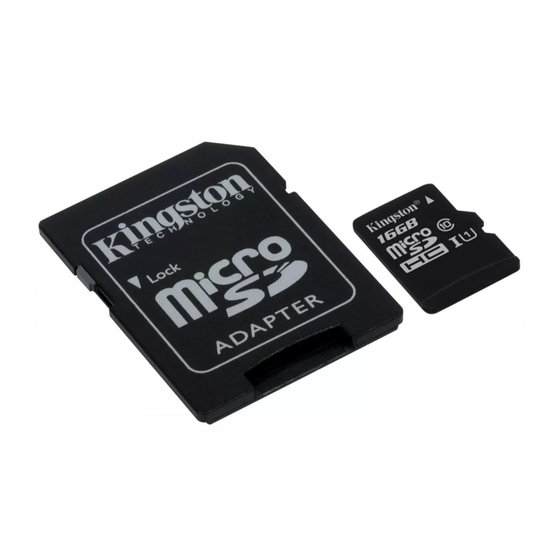
Advertisement
Quick Links
Flash Memory Guide
Portable Flash memory for computers, digital cameras, cell phones and other devices
Kingston
, the world' s leading independent manufacturer of memory products, offers a broad range
®
of Flash cards and USB Flash drives (collectively called Flash storage devices) that employ Flash
memory chips for storage. The purpose of this guide is to explain the various technologies and
Flash memory offerings that are available.
Note: Due to Flash technology changes, specifications listed in this document
are subject to change without notice.
kingston.com.flash
c o M M I T T E D T o M E M o r y
Advertisement

Summary of Contents for Kingston Technology Flash Memory
- Page 1 Flash Memory Guide Portable Flash memory for computers, digital cameras, cell phones and other devices Kingston , the world’ s leading independent manufacturer of memory products, offers a broad range ® of Flash cards and USB Flash drives (collectively called Flash storage devices) that employ Flash memory chips for storage.
- Page 2 Flash Memory: Empowering A New Generation of Flash Storage Devices Toshiba invented Flash memory in the 1980s as a new memory technology that allowed stored data to be saved even when the memory device was disconnected from its power source. Since then, Flash memory technology has evolved into the preferred storage media for a variety of consumer and industrial devices.
- Page 3 3. Reserving some cells to serve as “spares.” Flash memory cells have a long but finite lifetime. Therefore, some cells are held in reserve to replace any memory cells that may fail over time. 4. Creating a File Allocation Table (FAT) or other directory. To enable Flash storage devices to conveniently store and access customer files, a file management system must be created to allow any device or computer to identify the files stored in the Flash storage device.
- Page 4 • Wear-Leveling Technology: Kingston Flash storage devices incorporate controllers utilizing advanced wear-leveling technology, which distributes write cycles across the Flash card. Wear-leveling thus extends the useful life of a Flash memory card (for details, Kingston engineers please see Kingston Flash Cell Endurance section, next).
- Page 5 Flash storage device is removed from a digital camera, all data (and pictures) remains saved on the Flash storage device. The ability to retain data is key for Flash memory applications such as digital film for digital cameras, cell phones, PDAs and other transportable devices.
-
Page 6: Nand Flash Memory
NAND Flash memory is less expensive than NOR Flash memory, and can accommodate more storage capacity in the same die size. Flash memory which stores a single bit per cell (e.g., a value of “0” or “1” per cell) is known as Single-Level Cell (SLC) Flash. - Page 7 5.2 MulTI-lEvEl cEll (Mlc) FlASh TEchNoloGIES NAND and NOR Flash memory chips store one (1) bit value (a “0” or a “1”) in each cell. In multi-level Flash technologies, two (2) or more values are stored into each cell.
- Page 8 Flash Storage Device Performance Flash card storage device performance depends on the following three factors: • The specific Flash memory chips used: Generally, there is a tradeoff between the high-speed and more expensive Single-Level Cell (SLC) Flash chips, and the standard speed and more affordable Multi-Level Cell (MLC) or Multi-Bit Cell (MBC) Flash chips.
-
Page 9: Usb Flash Drives
kingston.com/flash Kingston’s Flash card Product lines There are several types of Flash storage devices that are available from Kingston: - USB Flash Drives (DataTravelers) - Secure Digital Cards (SD, SDHC, miniSDHC, microSD, microSDHC) - CompactFlash Cards ® 7.1 uSB FlASh DrIvES Introduced in 2002, USB Flash drives offer an incredible combination of high storage capacity, fast data transfer rates, and great flexibility, all in the palm of your hand. - Page 10 kingston.com/flash 7.3 SEcurE DIGITAl cArDS (SD, SDhc, miniSDhc, microSD, microSDhc) Secure Digital, introduced in late 2001, is a second-generation derivative of the MultiMediaCard (MMC) standard (see section 7.4). The Secure Digital format includes several important technological advancements over MMC. These include the addition of cryptographic security protection for copyrighted data/music.
- Page 11 kingston.com/flash 7.4 MulTIMEDIAcArD (MMcmobile) MultiMediaCards, like SD cards, are one of the smallest Flash cards available, about the size as a postage stamp. They were introduced in 1997 and initially used in the mobile phone and pager markets. Today, they are commonly used in digital cameras, MP3 players and other digital devices.
-
Page 12: For More Information
kingston.com/flash For Flash media, Kingston recommends the flexible and convenient Media Reader, a single reader that supports nineteen Flash card formats and can be connected to any computer with a Hi-Speed USB 2.0 port. Kingston also offers convenient portable readers, MobileLite 9-in-1, DataTraveler Drive + Reader and microSD Readers for high-performance data transfers to systems supporting Hi-Speed USB 2.0. - Page 13 M M I T T E D T o M E M o r y ©2007 Kingston Technology Company, Inc. 17600 Newhope Street, Fountain Valley, CA 92708 USA Printed in the USA MKF-403.15...














Need help?
Do you have a question about the Flash Memory and is the answer not in the manual?
Questions and answers